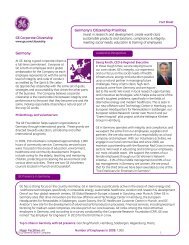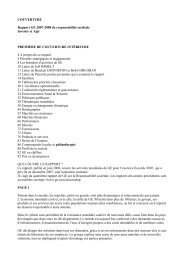Smart Homes - GE : imagination at work - General Electric
Smart Homes - GE : imagination at work - General Electric
Smart Homes - GE : imagination at work - General Electric
Create successful ePaper yourself
Turn your PDF publications into a flip-book with our unique Google optimized e-Paper software.
<strong>GE</strong> Energy<br />
Empowering smarter energy choices<br />
There’s more to home energy management than<br />
adjusting a thermost<strong>at</strong> or switching to compact<br />
fluorescent lamps. A smart-grid-enabled home, with<br />
smart metering, time-of-use pricing and simple user<br />
interfaces, enables consumers to make more intelligent<br />
energy choices — helping them manage energy usage<br />
and save money without compromising their lifestyles.<br />
At the same time, smart homes help utilities manage<br />
peak loads, lower the need for additional peaking<br />
power plants, and reduce costs.<br />
The old way:<br />
Consumers “managed” energy consumption with onedimensional<br />
changes, such as fluorescent lights and<br />
programmable thermost<strong>at</strong>s. They had no compelling,<br />
ongoing evidence th<strong>at</strong> it paid to be more vigilant.<br />
The smarter way:<br />
<strong>Smart</strong>-grid-enabled smart homes with time-of-use<br />
metering and energy-management tools help<br />
consumers monitor, manage and control energy usage,<br />
while helping them optimize performance and reduce<br />
energy losses from major appliances, he<strong>at</strong>ing, cooling,<br />
and lighting. With smart grid, consumers can manage<br />
energy usage and costs throughout the day, without<br />
compromising their lifestyles.<br />
<strong>Smart</strong> <strong>Homes</strong> –<br />
Empowering<br />
Consumers to<br />
Manage Energy<br />
Usage & Save<br />
Money Every Day
The facts:<br />
• Residential electricity prices are on the rise. 1<br />
• The open-market mine price of coal, which accounts<br />
for 50% of U.S. net electricity gener<strong>at</strong>ion 2 , increased<br />
nearly 40% from 1995 to 2007, and is expected to<br />
• The cost to build power plants is rising. 4<br />
• Anticip<strong>at</strong>ed federal legisl<strong>at</strong>ion will likely force coalfired<br />
gener<strong>at</strong>ors to pay carbon taxes, adding yet<br />
more cost for consumers. 5<br />
rise in 2009. 3<br />
<strong>Smart</strong> <strong>Homes</strong> make every household a potential source of savings<br />
Home Energy Challenges<br />
<strong>Electric</strong>ity prices are climbing and<br />
most consumers are not empowered<br />
with inform<strong>at</strong>ion to manage energy<br />
usage and costs.<br />
<strong>Smart</strong> Grid Advantages<br />
Most consumers don’t realize the cost of electricity varies based on<br />
demand. <strong>Electric</strong>ity is cheaper to produce during off-peak hours and<br />
more expensive during peak hours when additional gener<strong>at</strong>ion is<br />
needed. Yet most residential electricity customers pay one set price —<br />
regardless of the time of day. <strong>Smart</strong> meter technologies enable “time<br />
of use” pricing, which offers lower prices during off-peak periods.<br />
A U.S. Department of Energy study showed th<strong>at</strong> smart grid consumers<br />
were able to save 10% on power bills and cut power use 15% during<br />
peak hours with access to time-of-use pricing inform<strong>at</strong>ion. 6<br />
Even the most-high-tech appliances<br />
run on their own schedules with no<br />
regard for energy availability or<br />
electricity costs.<br />
Within 10 years, <strong>GE</strong> energy-management-enabled appliances could be<br />
as common as ENERGY STAR ® products today. <strong>GE</strong> is investing in these<br />
appliances to help consumers use less energy and reduce their utility<br />
costs in the future.<br />
These appliances <strong>work</strong> with the smart meters to avoid peak-hour<br />
energy usage and top-tier pricing — without any neg<strong>at</strong>ive impact on<br />
the consumer. How The autom<strong>at</strong>ic defrost cycle in most refriger<strong>at</strong>ors<br />
is initi<strong>at</strong>ed based upon the number of door openings. Whenever the<br />
count is high enough, the cycle begins regardless of the time of day or<br />
cost of electricity <strong>at</strong> th<strong>at</strong> time. In a smart refriger<strong>at</strong>or, the appliance<br />
will track door openings and the cost of electricity, enabling the<br />
refriger<strong>at</strong>or to defrost when it’s cheapest to do so. This shift in timing<br />
will help to save the consumer money, and will also help to reduce the<br />
power requirements on the grid <strong>at</strong> peak times.<br />
Home-based renewable gener<strong>at</strong>ion<br />
can slash household emissions and<br />
lower energy bills. But this is not yet<br />
widely adopted.<br />
With a smart-home mindset and smart-grid-enabled net metering,<br />
consumers will have the ability to easily sell excess power back to the<br />
grid without problems. Plus, with time-of-use pricing, consumers are<br />
incented to sell back to the grid during peak hours <strong>at</strong> higher r<strong>at</strong>es,<br />
further offsetting rising power bills.<br />
1<br />
Energy Inform<strong>at</strong>ion Administr<strong>at</strong>ion. “Short Term Energy Outlook.”<br />
http://www.eia.doe.gov/emeu/steo/pub/jan09_text.pdf. January 2009.<br />
2<br />
Energy Inform<strong>at</strong>ion Administr<strong>at</strong>ion. “<strong>Electric</strong> Power Industry 2007: Year in Review.” Figure ES 1: U.S. <strong>Electric</strong><br />
Power Industry Net Gener<strong>at</strong>ion, 2007.<br />
http://www.eia.doe.gov/cneaf/electricity/epa/epa_sum.html. 21 January 2009.<br />
3<br />
Energy Inform<strong>at</strong>ion Administr<strong>at</strong>ion. “Coal prices.” Average Open Market Mine Price of U.S. Coal 1995-2007.<br />
http://www.eia.doe.gov/neic/infosheets/coalprice.html. February 2009.<br />
4<br />
I.H.S. and Cambridge Energy Research Associ<strong>at</strong>es (CERA). Power Capital Costs Index.<br />
http://energy.ihs.com/News/Press-Releases/2008/North-American-Power-Gener<strong>at</strong>ion-Construction-<br />
Costs-Rise-27-Percent-in-12-Months-to-New-High-IHS-CERA.htm. 14 February 2008.<br />
5<br />
Davidson, Paul. USA Today. “Price Jolt: <strong>Electric</strong>ity bills going up, up, up.” 20 June 2008. http://www.us<strong>at</strong>oday.com.<br />
6<br />
Department of Energy’s Pacific Northwest Labor<strong>at</strong>ory, GridWise project, January 9, 2008<br />
For more inform<strong>at</strong>ion, contact <strong>GE</strong> Energy T&D<br />
Communic<strong>at</strong>ions:<br />
Margaret Chapman: Margaret.Chapman@ge.com<br />
or 678-844-5869<br />
Allison Eckelkamp: Allison.Eckelkamp@ge.com or<br />
678-844-6849<br />
© 2009 <strong>General</strong> <strong>Electric</strong> Company. All Rights Reserved.<br />
<strong>GE</strong>A-10003MC (03/09)
















